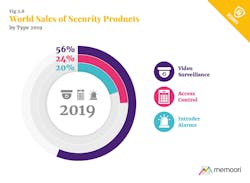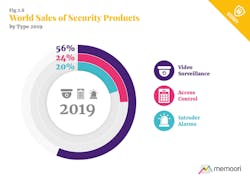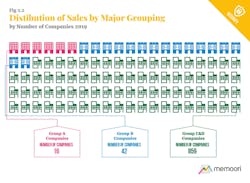Report: Physical security equipment sales grow as global demand becomes unbalanced
Memoori’s new annual report shows that total value of world production of physical security products at factory gate prices in 2019 was $34.3 billion, an increase of 8.5%.
Of the three product categories covered in the report (video surveillance, access control and intruder alarms), video surveillance had the highest rate of growth at 9.7% over the last three years and accounts for 56% of world sales. Western manufacturers have competed better against Chinese competition this year, but they still have little possibility of penetrating the Chinese public sector business. China is by far the largest single market probably accounting for 35% to 40% of world demand for video surveillance.
Access control was expected to deliver slightly higher growth than the 8.2% Memoori had estimated in 2019. It now accounts for 24% of word sales. It continues to expand the IP network business, advancing deeper into biometric, identity management, wireless locking systems and ACaaS. This would have been the third consecutive year that it turned in the highest rate of growth of the three businesses, but price pressures are starting to bite, partially through consolidation and weaknesses in the supply chain. This has reduced growth when measured by value.
Top Vendors Consolidate Their Grip
Sixteen Group A companies (those we believe have a physical security business over $1 billion in sales) account for 67% of sales in 2019, continuing to grow their share at the expense of smaller companies. In Group B, we identified 42 companies (three more than last year) having sales of over $100 million but less than $1 billion and taking a 19.5% share of the business but 4.2% of the population of companies.
The China Challenge
The problem for Western manufacturers getting a piece of the China market is not about technology or performance, at its core it is a geopolitical challenge.
Demand structure in the video surveillance business is unbalanced because of the Chinese market. The main reason is that the communist government has some control over even private video surveillance manufacturing companies. If these companies want public sector business (which today could account for more than 50% of the Chinese’s video surveillance market) and support with long term cheap loans, then they must comply with the states requirements.
For this the government ensures that foreign equipment will not be used on public sector projects. Not surprisingly this arrangement has distorted any possibility of “open trade” and further has allowed the two major Chinese manufactures to build up a market share of 40% of the worlds video camera business; in part by operating a “race to the bottom” by lowering prices that no other manufacturers could sustain because they don’t have the same volume of production.
However, on the horizon are other Chinese companies that want a part of the massive investment in the public sector projects. Huawei, one of the world’s largest communication companies, have announced a major push into video cameras and an AI video analytics startup Megvii intends to offer complete video surveillance solutions. They will eventually get established in the public sector market and take share from the two present incumbents, and this could at least reduce the pressure on non-Chinese manufacturers operating in the more open world market.
This article has been taken from the 11th edition of Memoori’s Annual Report, “The Physical Security Business 2019 – 2024.”
Jim McHale is Managing Director of Stockholm-based market research firm Memoori.
About the Author

Jim McHale
Managing Director, Memoori
Jim McHale is managing director of Stockholm-based market research firm Memoori.


